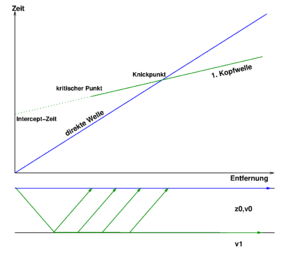Break point (seismic)
In refraction seismics, the point of intersection of the travel time curves of the direct and head wave in the travel time diagram is referred to as the break point . While the direct wave propagates with the velocity v 0 of the uppermost layer, the head wave propagates along the interface with the velocity of the underlying layer v 1 .
The break point is the place where the head wave “overtakes” the direct wave because it is moving at the greater speed. At a measuring point that is further away from the source of the seismic energy than the so-called break point distance , the head wave is recorded as a first use. To identify the sequence of layers in the subsurface, the breakpoints must be precisely identified.
With
- : Break point
- : Thickness of the upper layer
- : Seismic velocity of the direct wave (top layer)
- : Seismic velocity of the head wave (underlying layer)
See also:





